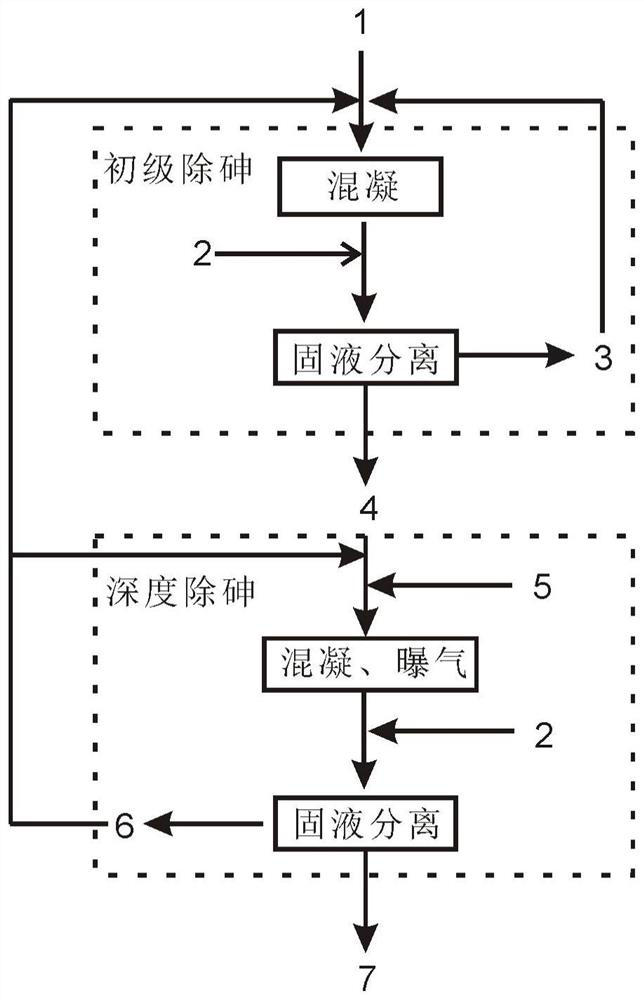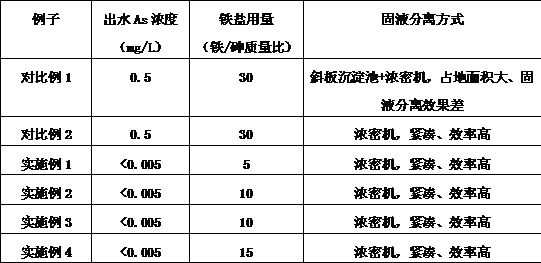Step deep purification method for low-concentration arsenic-containing wastewater
A step-depth, low-concentration technology, applied in chemical instruments and methods, water pollutants, water/sewage treatment, etc., can solve the problem that the treatment indicators are easily affected by the external environment, the stability of calcium arsenate-containing slag is poor, and it does not meet the national environmental protection requirements. Standards and other issues, to achieve the effect of clean production, slag reduction, and high chemical efficiency
- Summary
- Abstract
- Description
- Claims
- Application Information
AI Technical Summary
Problems solved by technology
Method used
Image
Examples
Embodiment 1
[0036] Initially, the low-concentration arsenic-containing wastewater (As 5mg / L) was treated with polyferric sulfate, and the mass ratio of iron to arsenic was 4 for primary arsenic removal, and then the low-concentration arsenic-containing wastewater was combined with primary arsenic removal bottom flow and deep arsenic removal bottom flow (control The mass ratio of iron / arsenic is 20), stirring in the reaction tank for 30 minutes, the stirring line speed is 2m / s, and the pH detection device of the reaction tank is interlocked with the metering peristaltic pump of sulfuric acid or lime milk, so that the pH of the reaction is controlled at 7 ~9. Pump the preliminary arsenic removal slurry to the thickener, and at the same time add a polyacrylamide polymer flocculant with a concentration of 0.1% to the feed barrel of the thickener, and control the amount of the polyacrylamide polymer flocculant to 3g / t for the initial removal Arsenic slag; the dense underflow part of preliminar...
Embodiment 2
[0038] Initially, the low-concentration arsenic-containing wastewater (As 3 mg / L) was treated with polyaluminium chloride, and the mass ratio of aluminum to arsenic was 7 for primary arsenic removal, and then the low-concentration arsenic-containing wastewater (As 3 mg / L) was combined with primary arsenic removal Underflow and deep arsenic removal underflow (control the mass ratio of iron / arsenic to 20), stir in the reaction tank for 20 minutes, the stirring line speed is 2m / s, and interlock the pH detection device of the reaction tank with the peristaltic pump for sulfuric acid or lime milk metering , so that the pH of the reaction is controlled at 7~9. Pump the preliminary arsenic removal slag to the thickener, and at the same time add polyacrylamide macromolecule flocculant with a concentration of 0.2% to the feeding barrel of the thickener, and control the amount of polyacrylamide polymer flocculant to 5g / t for preliminary arsenic removal slag; The dense underflow part of ...
Embodiment 3
[0040] Initially, the low-concentration arsenic-containing wastewater (As 2mg / L) was used as a coagulant combined with ferric sulfate and polyaluminium chloride, and the mass ratio of iron (aluminum) / arsenic was 10 for primary arsenic removal, and then the low-concentration arsenic-containing wastewater ( As 2 mg / L) with the primary arsenic removal bottom flow and deep arsenic removal bottom flow (control the iron / arsenic mass ratio to be 30), stir in the reaction tank for 10min, the stirring line speed is 1.0m / s, and the pH detection device of the reaction tank Interlocking control with sulfuric acid or lime milk metering peristaltic pump to control the pH of the reaction at 7~9. Pump the preliminary arsenic removal slag to the thickener, and at the same time add polyacrylamide with a concentration of 0.1% to the feed barrel of the thickener, and control the amount of polyacrylamide to 8g / t dry preliminary arsenic removal slag; preliminary arsenic removal dense The underflow ...
PUM
 Login to View More
Login to View More Abstract
Description
Claims
Application Information
 Login to View More
Login to View More - R&D
- Intellectual Property
- Life Sciences
- Materials
- Tech Scout
- Unparalleled Data Quality
- Higher Quality Content
- 60% Fewer Hallucinations
Browse by: Latest US Patents, China's latest patents, Technical Efficacy Thesaurus, Application Domain, Technology Topic, Popular Technical Reports.
© 2025 PatSnap. All rights reserved.Legal|Privacy policy|Modern Slavery Act Transparency Statement|Sitemap|About US| Contact US: help@patsnap.com


